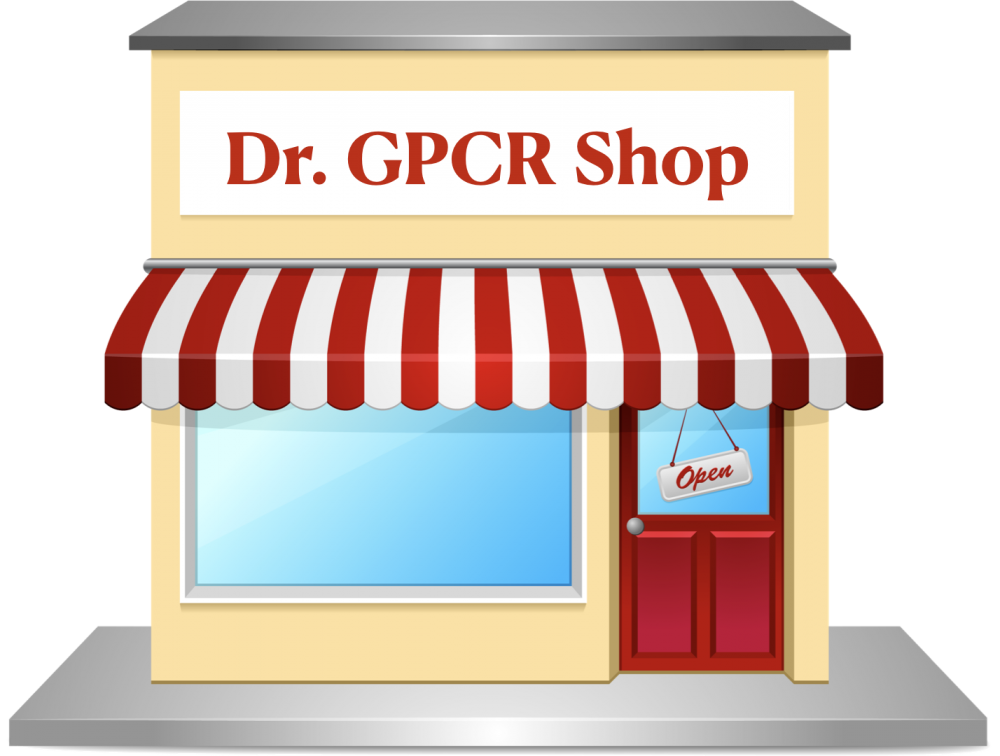Listen and subscribe where you get your podcasts
About this episode
In 1975, Dr. Paul Insel was at the FASEB experimental biology meeting in Atlantic City. During dinner with colleagues and Alfred Gillman, co-recipient of the 1994 Nobel Prize in Physiology or Medicine for their discovery of G-proteins and their role in signal transduction in cells, Paul was designated to go to Gillman’s lab. That summer, he used radioligand binding methods to dissect receptor function from the adenylyl cyclase activated by ligands, including adrenaline. From that point on, Paul was hooked and has since studied receptor function in human physiology, receptor molecular pharmacology in cells, and animal models, and as he puts it has now he’s "gone full circle" back to studying GPCRs important in human pathophysiology. Today, Paul and his team focus on previously unrecognized receptors with the hopes to use these as novel drug targets.
Dr. Paul Insel on the web
Episode transcript
Dr. Yamina Berchiche 0:49
Hi Paul, thank you for being here today. So you are currently a professor at the University of California San Diego. Can you tell me about your background and how you got to where you are today?
Dr. Paul Insel 1:01
Sure. So I originally trained as a physician, I obtained my MD from the University of Michigan.
I was one of these kids that went to school very fast, and ultimately did some training in internal medicine at Harvard Medical Unit at the Boston City Hospital in the late 60s, actually, and then went to the National Institute of Health for several years, and did physiology in people and then biochemistry and a different lab, spent four years there. Then I went into I went to the University of California, San Francisco, in an area that was then called clinical pharmacology, but what I did was really basic pharmacology and worked with Henry Born and others and I got very involved in molecular pharmacology and ultimately went on the faculty at UCSF for about a year and a half and then relocated to the University of California at San Diego, which was a much younger newer school. I was the first MD hired into what was called the Pharmacology Division at the Department of Medicine. I was responsible to do clinical work as well as the research, and that's pretty much what I did for most of my career here at UCSD, where I'm now a distinguished professor of pharmacology and medicine. I don't see patients anymore, but I've continued my research and played a very active role in physician-scientist training as the director of an MD / Ph.D. Medical Scientist training program that I've now been involved with as director for over 30 years.
My research has evolved from early studies that, as I said, started out with human physiology, and has actually come full circle in a certain way, where I've gotten very interested in human beings later in my career, so to speak, in terms of their involvement in molecular mechanisms that I've been studying, and would spend most of my career studying signal transduction, especially by receptors, that activate, regulate cyclic AMP and the effects of cyclic AMP through protein kinase A and to a lesser extent EPAC. I basically spent a lot of time doing that and looking at both cells in culture and to some extent studies in various animal models. But early on, also the studies on people, to try to identify tissues or cells that had receptors and went to study ex-vivo from human beings. That's actually where a lot of our research focuses today, trying to identify GPCRs that are particularly important in certain disease states and have been previously unrecognized GPCRs that may be physiologically and pathologically important.
Dr. Yamina Berchiche 4:35
That's fantastic. And during your career that has spanned over a couple of decades by now, when was that moment when you felt like you were catching on to something that was related to GPCRs? When did you get interested in GPCRs? And when did you realize that they played an important role?
Dr. Paul Insel 4:56
Actually, I started getting interested in GPCR signaling, we didn't call them GPCRs, and we didn't know about the G part, but when I was at NIH, my earliest experiments in this regard were to try to understand cAMP action in the kidney and looking at cyclic AMP binding proteins in the renal membrane. Ultimately realizing later that it was protein kinase A I was probably studying.
That was sort of trying to complement other people's work at the National Institutes of Health that was looking at hormones that work through what we now would call GPCRs. During the latter part of that time, there was the use and discovery of radioligand binding techniques by Bob Lefkowitz, Al Gillman, and others. I witnessed all of that. I got sort of interested in it back before I left the NIH and then I went to UCSF, and I worked on protein kinase A for about a year.
What actually happened, which is kind of a funny story, I think. I went to an experimental biology meeting then called the FASEB meeting in Atlantic City, in 1975 and I had dinner with several people from the lab I was working with, along with Al Gillman, who was then at the University of Virginia. Based on the systems we were working on, we realized we could assess critically what was then a rather interesting question. It's sort of a joke now, but it was really interesting at the time, the proposal has been made that the surface receptors for adrenaline, or epinephrine or norepinephrine, actually contained the adenylyl cyclase that was being activated by those ligands.
We had a genetic model at the time that we thought would let us separate them, and so we were sitting around having dinner and someone said, well, someone has to go to Gillman's lab, take these cells and do these experiments because he's got these radioligand binding methods. As it turned out, everybody else was married and had something else they had to do. And they said it looks like you're gonna have to go and actually kind of leaped at the opportunity. I spent a few weeks in Al Gillman's lab getting to know him pretty well and learning radioligand binding techniques. This was in the summer of 1975, actually. And after that, I was kind of hooked and I sort of hung out with what then later became known as GPCRs, they're signaling mechanisms and regulation and expression, etc, pretty much for the rest of my career.
That was sort of a fluke that, you know, I was a single guy who could go to his lab and do these experiments, nobody else could do it.
Dr. Yamina Berchiche 8:21
That's fascinating.
Dr. Paul Insel 8:23
It wasn't one of those things that just happened. I happened to be at that dinner and happened to be the guy who was targeted to go, you know.
Dr. Yamina Berchiche 8:32
At the right time at the right place, right. That's fascinating. And through all these years, did you work on a specific GPCR or GPCR family that you would call your favorite GPCR?
Dr. Paul Insel 8:46
You know, it's interesting you say that I saw that was one of your questions. I thought about it. You know, actually, I've been married three times. I've had several loves among my GPCRs as well. It' really changed, I dit a lot on adrenergic receptors in the early years.
Obviously, Bob Lefkowitz was really dominant in that field. But we made some pretty, I thought, interesting observations about various aspects of adrenergic receptor signaling, expression, function, ligands and things like that, to detect them including studies in animals as well as in itself.
Then I sort of evolved. Over about a decade later, I got very interested in purinergic receptors and worked on those quite actively especially during the late 80s, 90s into the ‘00s for a while. I had had a couple of grants to do that and that was very productive with a whole series of collaborators in a lot of different areas, especially as related to the kidney and renal function.
About a decade ago or so I got very interested in a broader question of physiology, which was to ask, well, are we all studying the right thing? How do we know there aren't other GPCRs that we haven't thought about that are actually really important? I began to wonder and to actively think about how to use unbiased techniques to identify GPCRs. I got into using initially GPCR arrays, and more recently, RNA Seq and even single-cell studies, and discovered, in effect that there are lots of GPCRs that were highly expressed in a number of human, mouse, and rats cells and so forth and in tissues. I began to ask whether there were differences in disease models as well as disease patient samples? We've now been actively involved using bioinformatics techniques to look at database data as well as generating a lot of wet lab data from my own lab.
Over the last three or four years, my current favorite GPCRs are actually the proton sensing GPCRs, which have not been as well studied and I think are going to turn out to be very important, both physiologically and pathologically. That's actually what we're putting most of our efforts in my lab right now, along with some other receptors that are present in certain disease situations, especially as related to cancer. In particular, pancreatic cancer where we've now identified a whole series of GPCRs for which there are approved drugs that we think could be repurposed. Assuming that the drugs are agonist for those receptors and those receptors are acting alone and are able to produce aspects of the malignant phenotype, which we have evidence to suggest that's the case, we're hoping to get into the idea of repurposing some already approved drugs for cancer. This would help this idea that GPCRs can really be part of the cancer story.
I've kind of evolved back into human disease more than I was for many years. It's kind of a fun way to circle back to where I started. When I first went to the NIH. I actually helped work out some of the details of the glucose clamp technique for studying insulin and glucose action. All the experiments were done in humans, and so I'm kind of going back to my roots if you will, circling back at this point in my career.
Dr. Yamina Berchiche 13:00
Fantastic. Just to circle back to the proton sensing GPCRs. They're not as well known as the beta-adrenergic receptors, what can you tell us about their role physiologically?
Dr. Paul Insel 13:14
Well, that's still a work in progress. I mean, there are four members of this family. They've got several different names GPR4, GPR65, GPR68, GPR132. If you just use the numbers, they each have another name, too.
We don't have many drugs that attack them, either as agonists or antagonists or some allosteric modulators that have been described. But it's still I think, rather, an open field so to speak, in terms of trying to develop tool compounds for those. The receptors seem to be expressed in settings where you would expect low pH potentially to drive functional activities, including in parts of the kidney and in the lung, but pathologically, we literally stumbled on them, we didn't look for them. They talked to us rather than the other way around.
When we did an unbiased series of studies on pancreatic cancer-associated fibroblasts to our amazement, there was much higher expression of one of those receptors, GPR68, on the cancer-associated fibroblast compared to the precursor cells that are pancreatic fibroblasts and pancreatic stellate cells. That led us to develop a whole story around GPR68 as a way in which cancer cells talk to the fibroblasts and tell them to raise 68, then GPR68 responds to the low pH in the tumor microenvironment and talks back to the cancer cell, and almost certainly also stimulates the fibrotic activity of the fibroblasts. So it's a positive feedback loop if you will. That takes advantage of the fact that low pH exists in the tumor microenvironment. If the cancer is using that as a way to help promote its survival and growth and proliferation, we think it's a really cool concept that nature is taking advantage of and the proton sensing GPCRs could be really potentially important to drug targets. One of the other receptors GPR65 may also be involved in aspects of this, we're just starting to study that.
Dr. Yamina Berchiche 15:58
So in the context of these protons sensing GPCRs and their role in cancer, if we were to develop molecules targeting these in this context, we would be looking at antagonizing these receptors? Do I understand this correctly?
Dr. Paul Insel 16:14
Yes, that's correct. That's correct. Because of the low pH, the hydrogen H+ protons are acting as agonists for these receptors. The idea would be that you'd want to antagonize them or have an inverse agonist or negative allosteric modulator to inhibit the activation of these receptors.
Dr.Yamina Berchiche 16:40
That is absolutely fascinating. You were mentioning that these proton sensing receptors are overexpressed in cancer cells compared to the native tissues. Are there other GPCRs that are overexpressed in, for example, pancreatic cancer tissues?
Dr. Paul Insel 16:58
Yes. Let me restate you said Yamina, the proton sensing GPCRs are seen to be preferentially expressed in the cancer-associated fibroblasts in the tumor microenvironment. Generally not in the cancer cells. However, we just published a very large paper in Plos Biology a couple of months ago, in which one of the postdocs in my lab used a bioinformatics approach to compare the expression of all the GPCRs, excluding the non-chemosensor GPCRs, but all the others in particular. In 45 different kinds of human cancer, we showed that GPCRs have higher expression without necessarily having mutations, very frequently without increasing copy number variations, but very high expression of the receptor for reasons that have not been well defined yet. In a large number of diverse tumors, we’ve detected very high expression of different GPCRs
We believe, in many cases, there's very good evidence to think that they contribute to the pathophysiology in those cancers. Using human bioinformatics technique described in our Plos Biology paper, you're able to at least make a guesstimate as to which cell types within the tumors are those receptors most likely to be expressed, and some were preferentially expressed on the cancer cells some were on immune cells some were on the vascular elements, and some were on the fibroblasts. In each of those different cellular compartments, there may be GPCRs that really could be therapeutic targets for treating cancer, probably not as a single therapy, but rather as part of combination therapy of cancer. That's the kind of hypothesis we're working on right now.
Dr.Yamina Berchiche 19:27
Wow. And what are some of the challenges that you are facing when you look at targeting these different GPCRs in the context of cancer?
Dr. Paul Insel 19:39
Probably the biggest problem is getting money. Because I'll tell you that there's a lot of prejudice against I feel, maybe that's too strong a word, but it runs counter to the dominant thinking in the oncology world. It's all about the mutations that have occurred in the cancer cells and want to identify those patients and use personalized medicine to people because they've got particular mutations.
The GPCRs aren't particularly mutated. But we think they're still important and they contribute. We know that GPCRs can regulate metabolism, migration, growth, and death, and so forth. In some cases, we find receptors that are expressed 50 fold higher than normal, at very high levels, it's sort of hard for us to believe that they're not contributing in some way to the pathologic state. So that's why we're sort of intrigued by trying to push this idea into the cancer field, that not only are the chemokine receptors, which had been emphasized a bit, and some others, but there's a large number of GPCRs, quite a few, of the large GPCR families that we think could be playing a really active role in a large number of cancers. It's very striking when you start looking at the data critically, as a matter of getting the challenges to prove that that's the case, doing wet-lab experiments, if you will, we have a lot of dry lab data that really points to this, but we need to prove it unequivocally and validate these ideas. That takes money and people and a little bit of time, obviously and correct models to look at it both in cells isolated from patients, if possible, and using experimental animals as well to document. We've had very good success in our pursuit of a GPR68 for example, as I mentioned earlier.
Dr.Yamina Berchiche 21:57
Yes, absolutely. Well, let's say there is money, there are people in the lab working, there are models. What do you think should be the first steps to targeting some of these GPCRs that are overexpressed in either the cancer cells or the cancer microenvironment?
Dr. Paul Insel 22:17
Well, I think what one wants to do is to develop appropriate tool compounds if they don't exist. In the case you have drugs that are already out there, you know, we want to get started doing some documentation of the validity of these receptors. that they really are functionally active, that they signal, that they control functional activities in the different cell types, but then immediately move into animal models.
We've discovered in the case of pancreatic cancer, which is the one that we work mostly on, not exclusively, but mostly in our studies so far because we think that's such a huge unmet medical need. You know, classically, about 8-9% of people are alive after five years of being diagnosed. If you're ever diagnosed with pancreatic cancer, it's basically a death sentence. So we think this is a low hanging fruit, if we can get some drugs that would help make patients better it would be a really important effort. So in order to get that, what we've learned is you really need to take some of the animal models and show the efficacy and ultimately the safety of the drug that you're targeting these GPCRs with and see if they make a difference.
We've done one set of experiments recently in a mouse model of pancreatic cancer called KPC, that we've had access to and we've looked at a number of the GPCRs that we see are highly expressed in human cancers are also very highly expressed in the mouse cancer. So that provides for us at least a model that we can jump in. If you want to take a repurposed drug and say, hey, let's see if we add that drug to the KPC mice, these mice develop pancreatic cancer spontaneously in six to seven weeks to see if we can stop that. Can we slow their growth? Can we prevent cancer or can we treat it after it comes out? So we're just getting started doing a series of experiments like that.
Dr.Yamina Berchiche 24:30
Wow, fascinating. Since we're talking about speeding up drug discovery, speeding up discovering compounds to stop the progression of cancer, what is your opinion about machine learning and AI-based drug discovery in this context?
Dr. Paul Insel 24:44
You know, I don't have a good feeling for that, to be honest, but it's not clear to me how much one can develop a learning set, a training set, and then prove its utility. People were talking about that in terms of looking at different families of chemical compounds. I don't really have any experience. We are talking to chemists about ways to explore some of the receptors that we have looked at. We actually are in discussions with people about possibly launching a company around this and talked to a couple of chemists who are going to help us. We've got a couple of grants pending on this at NIH. But as far as your question about AI, and machine learning, you know, I'm not sure yet how that's going to accelerate this aspect of the drug discovery development process. I just don't have a good feeling about that. I know it's talked about but in this world that I'm living, and I'm still not sure how that's gonna be fully useful. Maybe it will. I don't think I can say that right now.
Dr.Yamina Berchiche 26:11
Would you? Would you be willing to give it a try and see if that would accelerate drug discovery?
Dr. Paul Insel 26:19
Yeah, I'm just not sure what one would use as the starting point for that. You know, if you have, I think if you had some compounds that look like they were decent tool compounds, as opposed to doing let's say, actual screening, and you can obviously do something. I should have said, you can clearly do in silico screening, no question about that. But that's not really machine learning or artificial intelligence that's just brute force computer work to get things to bind if you will or to interact with the target. Most of that work right now is heavily dependent on good crystal structures or Cryo-EM structures that identify particular pockets that may be binding pockets or allosteric modulator pockets. In the area that I was mentioning on proton sensors, some of the people in the field have described doing these in silico attempts to identify drugs that might be useful but they had to use the analogy with crystal structures that were out there.
We don't have crystal structures of these receptors I'm talking about. So, I think having a crystal structure really allows you to do that kind of work. That would be one way in which one can begin to refine and use AI or machine learning to come up with the chemical entities that might work. I don't have a lot of experience with this. So I'm just sort of fantasizing about it mostly, but certainly, others have used in silico docking, for example, with some success. I don't know that they started with what you really need, it really has to be based on a good structure. If you don't have that I'm not sure how good necessarily your data is gonna be, you need to start with the right substrate, so to speak. If that makes sense?
Dr. Yamina Berchiche 28.35
Absolutely. It does make sense. Definitely. I was thinking about when you were mentioning crystal structures, and that there's an accumulation of crystal structures that have become available over the past 20 years. Getting back to the proton sensing GPCRs. What do they look like compared to a beta-adrenergic receptor or rhodopsin for example?
Dr. Paul Insel 29:06
They're class A receptors. Data in the literature indicates that they have these extracellular histidines that are able to create the binding pocket of hydrogen ions. That's sort of how they are able to be activated by protons and, in turn, undergo conformational changes. It's kind of cool because, at least in the case of GPR68, it seems to work. There aren't very many receptors that do what it does, that is it links both to Gq and to Gs. I know of at least one purinergic receptor that does that. There are a few others but it's not that common in the GPCR superfamily that a GPCR would work through Gq and Gs. Our feeling is that some of the responses that have been described in the literature for this particular receptor, clearly appear to be linked to the Gq activation. In fact, most of them, what we found in the studies we did, is that it mostly links to the Gs activation. So we think it may be possible to develop biased ligands that will let's say, bias antagonists that will selectively knockdown the Gs linkage, which is linked to some of the effects I mentioned in the cancer-associated fibroblasts. Whereas some of the other effects that have been described for that receptor in the last 18 months or so, potentially involved in mechanical transduction, other functional activities. You wouldn't mess with that because those seem to be clearly linked to the calcium signaling.
Dr. Yamina Berchiche 31:00
You had mentioned biased antagonists. In the grand scheme of things for GPCRs in general as drug targets, where do you think the future of bias ligands is?
Dr. Paul Insel 31:13
Well, that's really a trick question. I literally just came from a talk an hour ago by Laura Bohn, who's one of the people who really pushed that idea truly actively in our seminar today as well as in the past.
She stepped back from it and said, you know, it's not as simple as people thought, whether it's just G proteins or beta-arrestin linkage. One bias and not another. I don't have a lot of strong feelings about this. I left that sort of biology guide me. In our system, it looks like we do see evidence of the functional activities that we described, which are mostly Gs determined and not Gq. But I think other data clearly says that Gq can do something and Gs doesn't. At the level of G proteins, I think there's clearly segregation but there's so much we still don't know about that. I mean, what is the proportion of Gq or Gs and their accessibility to different GPCRs in that case? But in other cases, where you see all these multiple linkages, you know, what Michel Bouvier refers to is plural, what is this word he uses real dynamic? I can't remember it. The multiple possibilities and what are all determinants for that, you know. I should look up that word because I'm just blanking on it right now. It's a word he coined. We don't quite know what the determinants of bias are. Some of the early work from a clinical point of view or a therapeutic point of view really hasn't really panned out quite yet. I think people jumped on the bandwagon about it over the last few years, and I'm not sure how it's gonna play out over time. If really, signaling activation of receptors is really a continuum of confirmations that are induced by agonist ligands, how are you going to make sure you really trap one and not another? How are you gonna clearly block one and not get some of the other? I think these are tricky questions that haven't been resolved yet.
Dr. Yamina Berchiche 34:04
Absolutely. I agree. Plus, if you want to add a layer of complexity over that, you have changes in GPCR expression, signaling transduction intracellular components that change from tissue to tissue to cell to cell. So it's a tricky one.
Dr. Paul Insel 34:21
Exactly. I totally agree. It's so different. I think. The one thing that I would just argue for, and this was actually something I started thinking this way early in my career and I got a little burned for this, I think people in science, in this area, particularly, there's been a reductionism on how people study it. I want to make a purified receptor. I want to see what are the minimal number of components that can activate. I want to get a crystal structure, but maybe to do that I have to make mutations to stabilize it. So we learn things about more purified components and what they can do in an isolated environment.
But from the beginning, early in my career when I first started cloning receptors, I started asking what goes on in intact cells? How do intact cells handle this? And you know, in fact, cells have all the GTP there. People can really study all transient phases by depleting GTP and or having GDP there when they do the binding in membranes and purified proteins reconstituted and stuff. I've always wondered about what's going on in native cells. And I think that's always been my concern about how it works. I once said, you know, someone once told me that, you know, if you ask the biochemist, how does the television work, you would probably take a wrecking ball to the television, and then take all the little pieces of the glass and the other parts and try to piece them back together. Because that's what the reductionism reconstitution model says. It's like, you know, understanding the brain by just understanding a neuron. Well, you can’t just have a neuron, right? So how do they all work together? This is why the grand initiative is talking about circuitry now because we got to talk about more than one neuron working together and stuff. I'm sort of jumping around a little bit, but my thinking is that you got to think about how the whole cells do their thing. And how was that environment different, whether it be the glycocalyx from the outside of the cells, whether it's the organization within the membrane and the interaction with the cytoskeleton. These are all parts of how the cell works, that we all strip away to try to understand how does the receptor work. I think science, going forward, I would suggest it's going to have to take, if you really want to understand how it works in vivo, you're going to have to really take those things into account and figure out the how-to methods and approaches for assessing native environments that can be then changed by the development of disease phenomenon environments.
Dr. Yamina Berchiche 37:31
Absolutely. I agree with you. Speaking of the future, what would be your advice to young scientists that are aspiring to work in the GPCR field?
Dr. Paul Insel 37:41
Well, I think the most important thing is to get good training and education, about science and don't get too narrow too fast. You have to get narrow to understand a particular problem in your research, but read widely, think about the connections with things that other people aren't thinking about. I've always felt like one of my strengths if I have any, is to try to see things from looking at different areas. I read in different fields, not just the GPCR field, and have tried to bring to bear some of those ideas on the GPCR field as they become operative in other areas. And both in terms of methodology and questions. I think, to the extent that people should keep open minds.
I think our training of a lot of young people today, it's almost too narrow for them to be able to think creatively. I think because they learn everything about this one little narrow field but you know, people outside that field they don't learn about what's outside. The future is going to be for people who can work at the interface of disciplines and who can understand how they don't have to just be a member of a team but they really have to make real contributions. I think you have to think as creatively as possible. I am not sure our funding system and our training are optimizing for that skill. Ironically, this is slightly off target but yesterday, I was in Los Angeles for my granddaughter's sixth birthday party. It was held at a place called Imaginology, and it's to teach kids about science and it was really cool. I got to talk at length with the owner of this place about how we can interest kids in asking questions that aren’t just observing but doing experiments even as elementary school kids so just to develop a love of science and thinking creatively and imaginably. It really was kind of inspiring to think that there are people putting together places like this to try to get the next generation of men and especially women and minorities to create diversity in people. NIH is trying to come up with all the strategies, what they really have to do is take a long term strategy, in my opinion, and start looking at younger people and getting them fired up for science and the creative process. And thinking about what I'm saying, ask questions about a variety of things that are not just in a narrow area. That was being on my podium.
Dr. Yamina Berchiche 40:50
Well, happy birthday to your granddaughter, first of all. To circle back to your comment about young scientists and what they should be looking at and also to the fact that In order to understand how GPCRs work, I think there is a parallel to be drawn. When you work on a GPCR or a mutation and you're spending four years to try to crystallize that one GPCR instead of being able to, look up from the bench and get an idea on what's going on in the tissue with that native receptor, I think I can see a parallel in that. Um, so you had mentioned in the beginning that you were at NIH, you were in Michigan to do your MD. So throughout your entire career, were there any moments, two to three AHA moments that you know, turn on that light bulb and you said, well, maybe this is what I should be doing? Other than that dinner with Alfred Gillman.
Dr. Paul Insel 41:50
Yeah, yeah. Well, that actually was, I remember, when we got our first data showing that cells, at the time we thought lacked the cyclase turned out to lack G protein or Gs protein, had excellent ligand binding to the receptor. That proved unequivocally that, AHA receptor cannot be the same as the key post-receptor components, which is what had been proposed by a Nobel laureate before that, and his coterie of protegees.
And so that was for me, that was kind of an AHA moment. I think the most, probably, the biggest AHA moment, at least in the last decade for me, has been the observation when a postdoc in my lab brought the first data regarding GPCR expression in a normal cell type. I looked at which receptors are the highest to express and the receptor that was the highest expressed was PAR1, the thrombin receptor, protease-activated receptor 1 (PAR1). And so I did what anyone would do. I said, well, let's look at what's wrong about that? And the answer was nothing. There's a receptor that nature decided to put at the highest level in these particular cells. No scientists had ever really studied it, there was one paper in neonatal cells. But I thought that was, I literally have considered that alarm. And I said, you know, this receptor has got functional activity, and nobody's ever studied it. And in fact, that was the case. That's actually been a big drive for me. The last time that happened about seven or eight years ago, maybe eight years ago. And I think since then, I've been really thinking more and more about it but you know, I've jokingly said in seminars are the unknown unknowns, we don't know what we don't know. I think that's been a real driver for how I approached the last several years of my scientific effort within a number of different cell types, I would point out not just the cancer story, but and we haven't published a lot of that, we're just starting to get some of it out now, but I really think that you got to keep an open mind. It's not all that we know, the beta-receptor is the beta receptor. There's a huge amount known about this. Now thousands of papers, but the beta-receptor may not be a paradigm for other receptors, and maybe it's not even as important as other receptors that nature has put into cells that are contributing both to functional activity and to disease. And if that's the case, we got to change our focus. And so that was I think, that's those two things, but you know, those are a couple of things that they were really inspirational well, AHA moments as you call them.
Dr. Yamina Berchiche 45:00
Absolutely, absolutely. Well, conclusion if just to go back to the beginning of the discussion, the conclusion with GPCRs, as we all know that they're complex, they're difficult to study, we need more tools to study them. But at the same time, they're fascinating. And I think we have a great future and a lot of people who are interested in uncovering these mysteries, such as the PAR1 receptor that you had mentioned, if nature put it there, it must have a function.
Dr. Paul Insel 45:31
Well, that's why I was gonna say, and add on to your lovely statement, you just made Yamina, I mean nature decided, for reasons that none of us will ever probably know for sure that GPCRs should be the largest receptor, membrane family. And it's a huge family. We saw that there are lots of orphans. We don't understand what they do, why they're there. What controls them? So there's plenty of work to do on things. And, you know, needless to say, when we looked at the receptor expression in tissue and some of those orphans are way highly expressed, and so you can't believe that they're there just to be vestiges of another time. And no, I think there's still a lot to be learned on these and this family. And people focus on one or another because that's how you have to do science but more broadly as a superfamily. It's incredibly important. I think we just need to begin to really rethink what's really important functionally, and especially in disease, I think there's really going to be some great opportunities both for understanding both pathophysiologies but also therapeutics from that. That's what's driving me in this phase of my career.
Dr. Yamina Berchiche 46:57
Absolutely. Absolutely. Thank you again, Paul for being here today, if you have any job openings in your lab, where can we find these?
Dr. Paul Insel 47:08
Good question people should write to me.
Dr. Yamina Berchiche 47:12
All right. Then as the last question, what are the hot conferences on GPCRs to learn more about your project that you're working on and that you would recommend to young scientists to attend this year?
Dr. Paul Insel 47:26
Yeah, I know, I'm co-chairing a GPCR Colloquium. That's going to be at the experimental biology meeting on April 3, and 4th in San Diego, just before the Experimental Biology (EB) 2020 meeting. And there's going to be some really terrific speakers and a number of people put in posters and I'd read the poster titles at least and know what the topics are. And I think it's going to be a really excellent meeting. It's being run by The Pharmacology Society ASPET, along with the physiology society, APS, American Physiological Society, and a number of companies are contributing and there'll be people there from a variety of small companies, especially who are GPCR focused. I think the first plenary address is going to be by Brian Kolbilka, of course, he won the Nobel Prize in 2012 for his work on GPCRs. But there's a lot of other excellent, excellent talks also. I think there's gonna be, I just learned there's a keystone meeting that's going to be held later in the year and it's going to be in Shanghai, I believe or in China. It's gonna be very structurally oriented, it doesn't look like there's a lot of functional stuff. The meeting I just described to you has a little bit of everything. The one I just described, the colloquium is going to have some stuff on structuring but also a lot of stuff on function and orphans and lots of different things, even though it's only a one-day pre-meeting. And there's, you know the Gordon Conference that's called Molecular Pharmacology and it's really G protein-coupled receptors. It's typically held every other year and it was held last year here in the United States. Every other year, it's either in the United States or Europe, but I believe it's going to be in Europe next year, probably in May, usually when it's held. So it's about a year from now. That's a great way to learn what's really going on in the GPCR field. I chaired that meeting at one point several years ago, and it's always very well attended by a really international group of scientists. The Keystone meetings actually, I think I chaired the first Keystone meeting on GPCRs, a number of years ago, as I said, it's evolved to be mostly about structure. Now, that really has been historically really a good meeting too. So those are a few, I think, coming up in the next 15 months or so.
Dr. Yamina Berchiche 50:16
Absolutely. Thank you so much. If I can add to that there is the annual Great Lakes GPCR meeting.
Dr. Paul Insel 50:23
Thank you for mentioning that, the Great Lakes meeting is a good meeting.I've been there once. I've only been there one time. Yeah.
Dr. Yamina Berchiche 50:31
That's usually a great meeting. Last year was the 20th anniversary of the meeting and we had Brian Kobilka and Bob Lefkowitz, both Nobel Prize Laureates come in and give a talk. It was fascinating.
Dr. Paul Insel 50:43
Oh, great. Yeah, that's a good meeting. It's been enjoyable. I think that some of the smaller meetings like that, or the GPCR Colloquium or the Gordon conference or the Keystone. are really great venues, but there's also a lot of really good stuff on GPCRs almost every year at the Experimental Biology meeting. So I think people from my lab often will go there because that's actually a good place.
Dr. Yamina Berchiche 51:10
All right, thank you so much for the discussion and for the great suggestions. And I really appreciate you taking the time to talk to us. I hope I was able to inspire the young and get more information out on GPCRs and the fascinating work that you're doing in your lab.
Dr. Paul Insel 51:26
Well, I hope it works out. I mean, I think it's a cool idea. I think it might just inspire young people on the field and I would love to see that happen.
Dr. Yamina Berchiche 51:34
Thank you so much, Paul. Thank you.
* The transcript has been minimally edited to improve readability


































